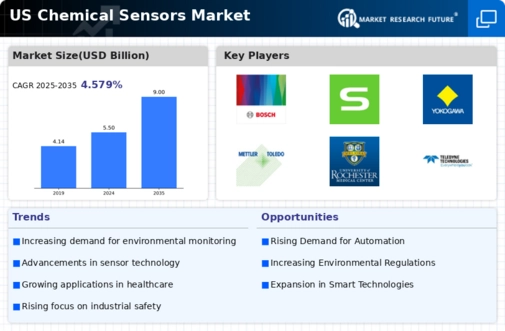Rising Environmental Regulations
The increasing stringency of environmental regulations in the US is a pivotal driver for the chemical sensors market. Regulatory bodies are mandating stricter monitoring of air and water quality, necessitating the deployment of advanced chemical sensors. For instance, the Environmental Protection Agency (EPA) has set forth guidelines that require industries to monitor emissions more closely. This regulatory landscape is expected to propel the market, as companies invest in chemical sensors to ensure compliance. The market is projected to grow at a CAGR of approximately 8% over the next five years, driven by the need for real-time monitoring solutions that can provide accurate data to meet regulatory standards. As industries adapt to these regulations, the demand for innovative chemical sensors is likely to surge, further solidifying their role in environmental protection efforts.
Expansion of Industrial Applications
The expansion of industrial applications is a significant driver for the chemical sensors market. Industries such as oil and gas, manufacturing, and food processing are increasingly adopting chemical sensors to monitor processes and ensure product quality. The need for real-time monitoring of chemical compositions and environmental conditions is driving this trend. For example, in the oil and gas sector, sensors are utilized to detect leaks and monitor emissions, which is crucial for operational safety and regulatory compliance. The market is projected to grow at a CAGR of approximately 8% as industries recognize the value of chemical sensors in enhancing efficiency and safety. This expansion reflects a broader trend towards automation and data-driven decision-making in industrial operations, further solidifying the role of chemical sensors in modern manufacturing.
Growing Demand in Healthcare Applications
The healthcare sector's growing demand for chemical sensors is a notable driver for the chemical sensors market. With the rise of personalized medicine and point-of-care testing, there is an increasing need for accurate and reliable chemical sensors that can monitor various health parameters. For example, sensors that detect glucose levels or other biomarkers are becoming essential in managing chronic diseases. The market for chemical sensors in healthcare is anticipated to expand at a CAGR of approximately 9% over the next few years, reflecting the sector's commitment to enhancing patient care through technology. This trend underscores the importance of chemical sensors in facilitating timely medical interventions and improving overall health outcomes, thereby solidifying their role in the healthcare landscape.
Technological Advancements in Sensor Design
Technological advancements in sensor design are significantly influencing the chemical sensors market. Innovations such as nanotechnology and advanced materials are enhancing the sensitivity and specificity of chemical sensors. These improvements enable the detection of lower concentrations of hazardous substances, which is crucial for safety in various applications, including industrial processes and environmental monitoring. The integration of IoT capabilities into chemical sensors allows for real-time data transmission and analysis, which is becoming increasingly important in sectors like manufacturing and healthcare. As a result, the market is witnessing a shift towards more sophisticated sensor technologies, with an expected growth rate of around 7% annually. This trend indicates a robust future for the chemical sensors market, as industries seek to leverage these advancements for improved operational efficiency and safety.
Increased Investment in Research and Development
Increased investment in research and development (R&D) is a critical driver for the chemical sensors market. As industries recognize the potential of chemical sensors in various applications, funding for R&D initiatives is on the rise. This investment is aimed at developing next-generation sensors that offer improved performance, durability, and cost-effectiveness. For instance, companies are exploring new materials and fabrication techniques to enhance sensor capabilities. The US government also supports R&D through grants and funding programs, further stimulating innovation in the chemical sensors market. This focus on R&D is expected to yield significant advancements, potentially leading to a market growth rate of around 6% annually. As new technologies emerge, they are likely to reshape the landscape of chemical sensors, making them more accessible and effective across diverse applications.





















Leave a Comment